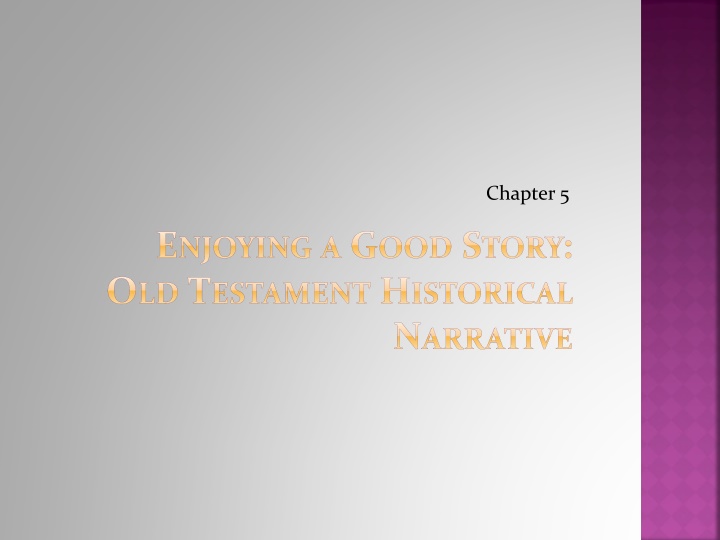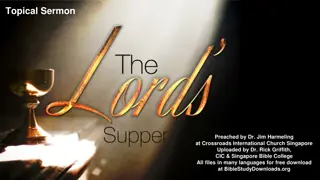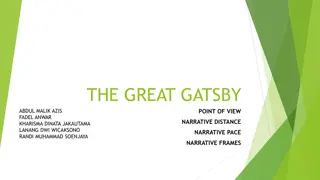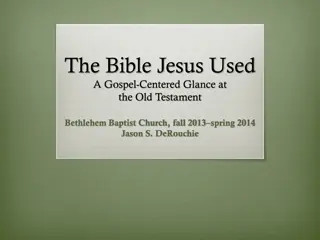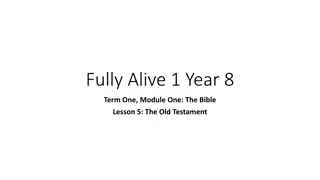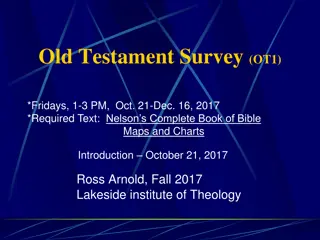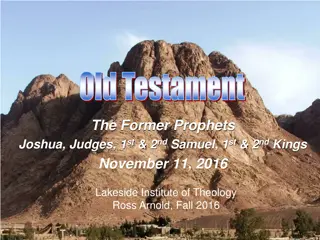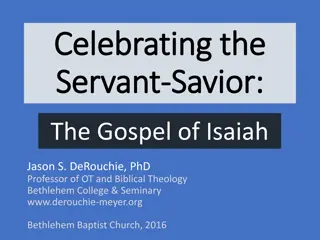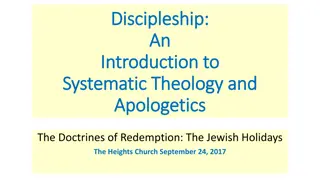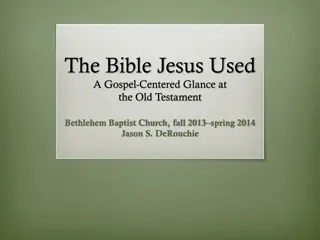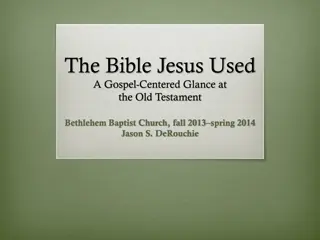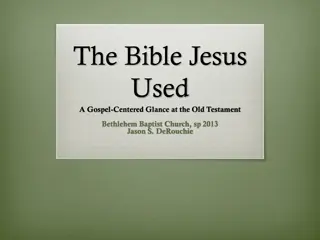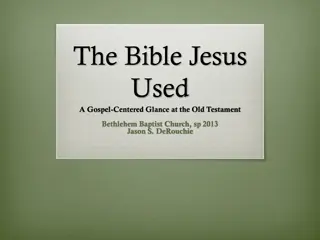Enjoying a Good Story: Old Testament Historical Narrative
Biblical narrative genres, modes of Old Testament historical narrative, elements, narrative style, and a sample exegesis from the Book of Esther are explored. The nature of biblical narrative and its modes are discussed, emphasizing the importance of interpretation in understanding the unique characteristics of each genre.
Download Presentation

Please find below an Image/Link to download the presentation.
The content on the website is provided AS IS for your information and personal use only. It may not be sold, licensed, or shared on other websites without obtaining consent from the author.If you encounter any issues during the download, it is possible that the publisher has removed the file from their server.
You are allowed to download the files provided on this website for personal or commercial use, subject to the condition that they are used lawfully. All files are the property of their respective owners.
The content on the website is provided AS IS for your information and personal use only. It may not be sold, licensed, or shared on other websites without obtaining consent from the author.
E N D
Presentation Transcript
Chapter 5 ENJOYING A GOOD STORY: OLD TESTAMENT HISTORICAL NARRATIVE
CHAPTER OUTLINE The Nature of Biblical Narrative The Modes of Old Testament Historical Narrative The Elements of Old Testament Historical Narrative Narrative Style Sample Exegesis: Book of Esther
THE NATURE OF BIBLICAL NARRATIVE Biblical genres or types of literature: historical narrative, poetry and wisdom, and prophecy in the Old Testament; historical narrative, parable, epistle, and apocalyptic in the New. The semantics of biblical literature : importance of interpreting each genre in keeping with its unique particular characteristics. Some have compared interpreting types of literature such as narrative, epistle, or apocalyptic to playing various games such as baseball, basketball, or soccer.
THE NATURE OF BIBLICAL NARRATIVE Narrative is a literary genre that builds its sentences and paragraphs around discourses, episodes, or scenes. Narrative studies recognize that meaning is found in a text as a whole rather than in isolated segments (Osborne). Narrative texts can appear in three different modes: story, account, and report.
THE MODES OF OLD TESTAMENT HISTORICAL NARRATIVE: STORIES Most often, narratives appear in dramatic form, that is, as stories that are presented by the biblical writer with a view toward driving home the significance of a given biblical event or series of events. Stories may be pure fiction or true stories of real people and real events. Certainly the stories of the Old Testament tell of real events. One of the major ingredients in many stories contained in the Old Testament is embedded oral discourse. For example, much of the patriarchal story of Joseph s adventures hinge upon speeches and dialogues. Although Joseph s story could have been told in straightforward narrative, the speeches and dialogues make not only for dramatic effect but also provide deeper understanding of the character of those involved.
THE MODES OF OLD TESTAMENT HISTORICAL NARRATIVE: STORIES Another frequent ingredient in biblical stories is description. Here the emphasis is on the background of the narrative or on the characters involved. In addition, biblical stories often involve commentary provided by the biblical writer. Here the narrator supplies parenthetical information in order to clarify a given element of the story or comments on the significance of a character s actions or a certain event.
THE MODES OF OLD TESTAMENT HISTORICAL NARRATIVE: STORIES It is also of interest to note that all or several of these elements speeches or dialogue, description, and commentary may be found in a single context. Thus after Israel s miraculous crossing of the Red Sea, we read of the following incident (Exod. 15:22 24): Description: Then Moses led Israel from the Red Sea and they went into the Desert of Shur. For three days they traveled in the desert without finding water. Narrative: When they came to Marah, they could not drink the water because it was bitter. Commentary: (That is why the place is called Marah.) Narrative: So the people grumbled against Moses, saying, What are we to drink?
THE MODES OF OLD TESTAMENT HISTORICAL NARRATIVE: ACCOUNTS Large sections of Old Testament narrative are written as historical accounts, including the Pentateuch and the so-called historical books (Joshua Esther). The historical material as written is not only factual information but also theological and doxological (accomplished ultimately by God and to his praise), didactic (in order to teach proper response and conduct), as well as aesthetically constructed (written with a view to achieving a pleasing literary work). It is theological history designedly so.
THE MODES OF OLD TESTAMENT HISTORICAL NARRATIVE: ACCOUNTS Jacob Lichtadds that biblical history is essentially all sacred history, in the sense of being ultimately concerned with the ways of God to men. Some of God s deeds, however, are perceived as being realized through the ordinary working of human agents, such as kings and rebels. Joshua 24 In sum, biblical historical narrative is more than an accurate account of past events; it is a selective presentation of the facts designed to present a theological evaluation of that record one that will bring about a proper spiritual and ethical response on the part of its readers.
THE MODES OF OLD TESTAMENT HISTORICAL NARRATIVE: REPORTS Biblical narratives may also contain a report that provides information of a historical nature (Numbers 13:27 29). The Old Testament narratives are replete with various reports (e.g., 2 Chron. 34:14 18; 2 Sam. 20:18 23, 35 42). In the prophetic genre, we find a special type of report known as a vocation report telling of the prophet s call and commission to the ministry. Other reports include: battle reports (e.g., Gen. 14:1 12; Josh. 10:1 15; 1 Sam. 31:1 7; 2 Sam. 1:1 10; 1 Kgs. 22:29 38; 2 Kgs. 25:1 21; etc.); census reports (Num. 1:17 46; Num. 26:1 62; 2 Sam. 24:4 9); lists or rosters; and vision reports (e.g., Gen. 46:2; 2 Sam. 7:4; Job 7:13 14; 20:8; 33:15; Ezek. 8:1 3; cf. Dan. 7; Mic. 3:6).
ELEMENTS OF OLD TESTAMENT HISTORICAL NARRATIVE: EXTERNAL ELEMENTS Author The real author is the one who actually wrote the narrative or story. What we know of this person from the narrative or story is termed the implied author. The implied author is the author as he or she would be constructed, based on inference from the text. Reader By the reader is meant the actual readers of the narrative; the implied reader is the one or ones for whom the author has composed his work. The readers may be the original audience, hence identical with the implied readers, or any who actually read the text including contemporary readers. Narrator A third distinction has to do with the one telling the story (the narrator) and the narratee the one to whom it is told.
ELEMENTS OF OLD TESTAMENT HISTORICAL NARRATIVE: INTERNAL ELEMENTS One must first determine the limits or boundaries of the narrative. An author often arranges his material in such a way that at the end of the narrative he will return to a theme, subject, or words mentioned at the beginning, known as book-ending or inclusio. In addition, J. T. Walsh points out that subunits in historical narrative accounts may be organized symmetrically as parallel sequences or in such a way that attention is called to the center of the account. Parallel sequences (ABC, A B C ) provide balance between the two subdivisions and stress the need for comparative examination of the details (Kings 13:11 34).
ELEMENTS OF OLD TESTAMENT HISTORICAL NARRATIVE: INTERNAL ELEMENTS Setting Physical location Time Cultural background Plot: the ordering of the events in the story Plot is concerned with the arrangement of details by which the story has a beginning, middle, and end. Each part of the story contributes to the fabric of the whole. The plot in biblical stories usually revolves around a conflict or contest (physical, psychological, or spiritual) and suspense (curiosity, dread, anticipation, or mystery). Example: Daniel 2 7
ELEMENTS OF OLD TESTAMENT HISTORICAL NARRATIVE: INTERNAL ELEMENTS Plot Narrative plots may also take the form of archetypal plot motifs. By archetypal plot, we mean features or experiences that are common to mankind. Quest Tragedy Journey
ELEMENTS OF OLD TESTAMENT HISTORICAL NARRATIVE: INTERNAL ELEMENTS Characterization Literary critics often describe a character as being round, flat, or simply an agent: A round (or full- fledged) character has many traits. A round character appears complex, less predictable, and therefore more real. A flat character has only one trait and seems one-dimensional. An agent, finally, has no personality to speak of and simply moves the story along. 1 Kings 18 22 Protagonist, antagonist
ELEMENTS OF OLD TESTAMENT HISTORICAL NARRATIVE: INTERNAL ELEMENTS Repetition Repetition is perhaps the most widespread and widely recognized stylistic feature of biblical narratives. We find seemingly endless catalogues of repeated actions, in which characters state that they or others intend to (or should) do something and then the narrator states that they did indeed do it. Highlighting The narrator often calls particular attention to some detail or character trait in the individual in the story. Irony Irony has to do with the reversal of what is said or expected. Old Testament narratives are filled with many such instances. Satire Satire consists of an attempt to demonstrate through ridicule or rebuke the vice or folly of that which appears to be improper or ill- conceived.
SAMPLE EXEGESIS: ESTHER History Literature Theology
GUIDELINES FOR INTERPRETING OLD TESTAMENT NARRATIVE Determine the limits or boundaries of the narrative at hand, while recognizing its internal structural features. Consider whether the narrative mode is direct, descriptive, dramatic, or commentary. Does the full context employ some combination of these? Ask yourself whether the historical narrative functions basically as an account or report, or is it told in story form. Does more than one of these forms occur in the full context? Come to grips with the respective roles of the author, reader, narrator, and narratee. Try to put yourself in the place of the narratee (or implied reader). Examine the setting of the narrative. What do you learn from such features as geography, time, or culture within the narrative? 1. 2. 3. 4. 5.
GUIDELINES FOR INTERPRETING OLD TESTAMENT NARRATIVE If the narrative is told in story form, look carefully for the flow of the story. Identify such features of the plot as its beginning, middle, denouement, resolution, and epilogue. Are there archetypal plot motifs present here? What biblical motifs and themes are resident in the full context? In stories, identify the protagonist, antagonist, and what foils may be present. Learn to appreciate the author s literary style, considering such features as dialogue, repetition, highlighting, irony, and satire. Throughout the interpretive process employ sound exegetical procedures, noting the contributions of grammar, history, literary constraints, and theological emphases. Drawing all of these data together, make a proper application to the contemporary situation. Ask how the narrative impacts the reader or hearer s spiritual life. 6. 7. 8. 9. 10.
